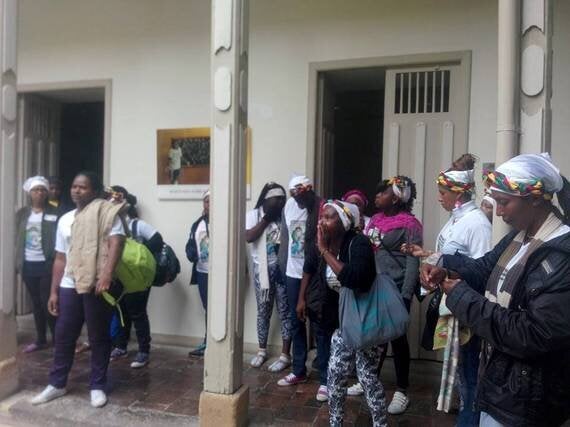Twenty two Afro-Colombian women staged a five-day occupation of the Colombian interior ministry from Thursday 27 November. The women marched from their community, La Toma, in Cauca's south west region, to the capital Bogotá to highlight the violence, militarisation and environmental destruction affecting their gold-rich territory.
The women's demonstration has brought international attention to the plight of communities hit by the government's drive to open up the country's natural resources to multinational companies, as well as the explosion of illegal mining by armed groups in rural territories across Colombia.
The march - dubbed "the March of the Turbans" by the women, because of their traditional headdress - arrived in Bogota last Wednesday. The women were granted talks with ministers the next day, but, unsatisfied with government indifference to their community's plight, they occupied the auditorium where the meeting took place.

Women from La Toma community occupying the Colombian Interior Ministry
What drove them to this?
La Toma is an Afro-Colombian community of around 5000 people, founded in the early 1600s by escaped slaves in a large mountainous area between the municipalities of Suarez and Buenos Aires. It has survived through small-scale artisanal mining, hand panning the river for traces of gold.
In the early 2000s paramilitaries arrived to this region and began to implement a scorched earth policy against the civilian population, committing horrific crimes against humanity including massacres and mass-scale forced displacements. Around the same time the government accelerated the giving of mining concessions to national and international investors, without the consent of the local Afro-descendent and indigenous communities, violating their collective territorial rights. Multinational companies exploited of the conflict and insecurity in order to acquire land and expand their operations, often using fraud and coercion to get their way, their way smoothed as the brutal violence of army and paramilitary forces smashed community resistance. By 2009, some 35 mining concessions had been approved in the areas surrounding the municipalities of Suarez and Buenos Aires.
In recent years, with the economic crisis pushing the international dollar price of gold high, La Toma has attracted the gaze of transnational corporations, such as South African Anglo Gold Ashanti. In 2009 La Toma community received eviction orders. More than 5,000 people were to be displaced, at the request of an individual who had received a mining licence in the community's territory. The individual has known links to AngloGold Ashanti and is widely believed to be a front-man for the company. The eviction was halted only after the community, supported by NGOs including War on Want's partner organisation, Asociacion Nomadesc, took its case before the Constitutional Court. Yet community leaders claim that since 2011 heavy machinery excavators have continued to operate illegally in their terriotry, guarded by unidentified, armed uniformed men, often with the complicity of state forces and local authorities. The river bed is being dug up by industrial excavators, leaving nothing but polluted water and piles of rubble. The community also faces the ongoing threat of displacement through the mining licenses granted without its consent. Licenses were suspended by CC Order 1045a, but have not been cancelled.
Attempts by people in La Toma to defend their territory have been met with increasing violence, militarisation and harassment. Two massacres have occurred in recent years: in April 2010, eight miners were killed by unidentified, uniformed armed men. And last year four unidentified men were murdered in the territory. The truth behind the massacres has never been established. Earlier this year, the community decided to remove the excavators themselves. Its leaders then received a letter signed by the Rastrojos paramilitary group, in which they were told that "we want a country without people like you. Let us work the mines because they belong to everyone. We are watching to see if you try to take away the machines that don't belong to you."
The women participating in "the March of the Turbans" have questioned the ongoing peace talks between the government and FARC guerrillas, stating that "without free territories, there can be no peace". They say that the situation facing La Toma community is not unique: many communities around Colombia are faced with the dual threats of multinational extractive companies seeking to enter their territories without community consent (often facilitated by military and paramilitary violence), and illegal mining carried out by paramilitaries and guerrilla forces. One of the group's leaders, Francia Marquez, explains why the community will continue to risk their lives in defence of their territory: "What I remember most about being a child is what my dad would say to me: this land is our and we have earned it with blood. That's why we must love it and defend it'.
Instead of continuing to increase trade and investment ties with Colombia, the governments of the UK, EU and US should heed the women's message and press the Colombian government to show the same regard for the rights of communities as it does for the welfare of multinational companies.